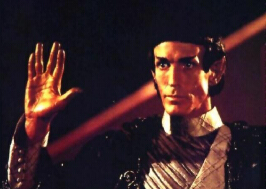first contact

First contact between humans and Vulcans in 2063 depicted in the film Star Trek: First Contact.
First contact is the moment at which two intelligent, communicative species, such as humankind and an extraterrestrial race, first encounter one another, either physically or via remote signaling. First contact is a goal and aspiration of SETI (Search for ExtraTerrestrial Intelligence) and CETI (Communication with ExtraTerrestrial Intelligence). It is also a familiar and much-used theme in science fiction enabling writers and movie makers to explore issues such as the nature of alien intelligence, the effect upon us of first contact, and the linguistic problems of establishing two-way communication with a species that may be similar in its stage of evolution to our own or, more likely, vastly more advanced.
Overview
Murray Leinster appears to have established the term "first contact" in science fiction in his eponymous 1945 novelette, although the theme had been used much earlier, for example by H. G. Wells in The Time Machine (1895), The War of the Worlds (1898) and, The First Men in the Moon (1901).
Entire series of novels have been devoted to the theme. One classic series is the "interstellar trader" series by Andre Norton. A more modern treatment, which uses radio signals rather than spacecraft, is Contact by Carl Sagan. Larry Niven and Jerry Pournelle's The Mote in God's Eye was written to be, in Niven's words, "the epitome of first contact novels". Here it is humanity which plays the role of the visiting aliens, as the religious, technological, political, psychological, military, cultural and biological implications of first contact are explored.
The Star Trek television series explores the theme frequently and in depth, and introduced the concept of the Prime Directive – a law which explicitly forbids first contact (or any form of interference for that matter) between humanity and its allies, and any and all races not sufficiently advanced (i.e. capable of interstellar travel) for such an encounter.
By contrast, in the novels of Iain M. Banks, the Contact division of the galactic civilization calling itself The Culture (which features in the majority of Banks' science fiction) are frequent manipulators of less advanced civilizations, steering them towards peaceful progress, especially those which may become aggressive or dangerous, under the pretense of maintaining the balance of galactic power. A notable exception being when the Culture encounters the Earth in the short story "The State of the Art" and deems humanity not to be worth contacting. Novels such as The Player of Games and Look to Windward delve into the psychology of first inter-species contact in considerable depth and it is in the novel Excession where Banks coins the phrase Outside Context Problem in relation to first contact.
The novel The Gods Themselves by Isaac Asimov eerily explores simultaneously the potential unity of all races, and the possibility of conflict that is inherent in all first contact situations: even as members of different races understand each other, their disparate ways may endanger both their worlds, even the fabric of their respective universes. This gap between individuals and their respective societies is characteristic of the First Contact plot of ET. Other explorations of the theme in popular culture include encounters with predatory or semi-sentient races as in Alien and Independence Day.
The absence of First Contact is evident in other works of science fiction, such as Asimov's Foundation series, where the Galactic Empire of Humanity is the undisputed ruler of the known cosmos, since no aliens exist. Examples of the mutual inscrutability and the potentially unbridgeable gaps between races which, by their very natures, are just too different to bond or even to accept each other, include Stephen Baxter's Xeelee Sequence concept of the dark matter photino birds, the god-like Firstborn from Arthur C. Clarke's Odyssey series. In other cases, such as Greg Bear's The Forge of God and Anvil of Stars, or Bruce Sterling's Schismatrix, aliens are presented as falling into a highly diverse spectrum, some easily relating with humans, others too alien for meaningful communication.
Anthropology and other fiction
Many stories about the old American West featured a first contact between European colonists and Native Americans. In Papua New Guinea, first contacts with hitherto unknown tribes were made as late as the 1930s.


